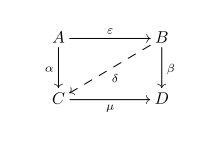|
Essential Monomorphism
In mathematics, specifically category theory, an essential monomorphism is a monomorphism ''f'' in a category ''C'' such that for a morphism ''g'' in ''C'', the morphism g \circ f is a monomorphism only when ''g'' is a monomorphism. Essential monomorphisms in a category of modules are those whose image is an essential submodule In mathematics, specifically module theory, given a ring ''R'' and an ''R''- module ''M'' with a submodule ''N'', the module ''M'' is said to be an essential extension of ''N'' (or ''N'' is said to be an essential submodule or large submodule of ' ... of the codomain. An injective hull of an object ''X'' is an essential monomorphism from ''X'' to an injective object. References {{cattheory-stub Category theory ... [...More Info...] [...Related Items...] OR: [Wikipedia] [Google] [Baidu] |
Mathematics
Mathematics is an area of knowledge that includes the topics of numbers, formulas and related structures, shapes and the spaces in which they are contained, and quantities and their changes. These topics are represented in modern mathematics with the major subdisciplines of number theory, algebra, geometry, and analysis, respectively. There is no general consensus among mathematicians about a common definition for their academic discipline. Most mathematical activity involves the discovery of properties of abstract objects and the use of pure reason to prove them. These objects consist of either abstractions from nature orin modern mathematicsentities that are stipulated to have certain properties, called axioms. A ''proof'' consists of a succession of applications of deductive rules to already established results. These results include previously proved theorems, axioms, andin case of abstraction from naturesome basic properties that are considered true starting poin ... [...More Info...] [...Related Items...] OR: [Wikipedia] [Google] [Baidu] |
Category Theory
Category theory is a general theory of mathematical structures and their relations that was introduced by Samuel Eilenberg and Saunders Mac Lane in the middle of the 20th century in their foundational work on algebraic topology. Nowadays, category theory is used in almost all areas of mathematics, and in some areas of computer science. In particular, many constructions of new mathematical objects from previous ones, that appear similarly in several contexts are conveniently expressed and unified in terms of categories. Examples include quotient spaces, direct products, completion, and duality. A category is formed by two sorts of objects: the objects of the category, and the morphisms, which relate two objects called the ''source'' and the ''target'' of the morphism. One often says that a morphism is an ''arrow'' that ''maps'' its source to its target. Morphisms can be ''composed'' if the target of the first morphism equals the source of the second one, and morphism com ... [...More Info...] [...Related Items...] OR: [Wikipedia] [Google] [Baidu] |
Monomorphism
In the context of abstract algebra or universal algebra, a monomorphism is an injective homomorphism. A monomorphism from to is often denoted with the notation X\hookrightarrow Y. In the more general setting of category theory, a monomorphism (also called a monic morphism or a mono) is a left-cancellative morphism. That is, an arrow such that for all objects and all morphisms , : f \circ g_1 = f \circ g_2 \implies g_1 = g_2. Monomorphisms are a categorical generalization of injective functions (also called "one-to-one functions"); in some categories the notions coincide, but monomorphisms are more general, as in the examples below. The categorical dual of a monomorphism is an epimorphism, that is, a monomorphism in a category ''C'' is an epimorphism in the dual category ''C''op. Every section is a monomorphism, and every retraction is an epimorphism. Relation to invertibility Left-invertible morphisms are necessarily monic: if ''l'' is a left inverse for ''f'' (meani ... [...More Info...] [...Related Items...] OR: [Wikipedia] [Google] [Baidu] |
Category (mathematics)
In mathematics, a category (sometimes called an abstract category to distinguish it from a concrete category) is a collection of "objects" that are linked by "arrows". A category has two basic properties: the ability to compose the arrows associatively and the existence of an identity arrow for each object. A simple example is the category of sets, whose objects are sets and whose arrows are functions. ''Category theory'' is a branch of mathematics that seeks to generalize all of mathematics in terms of categories, independent of what their objects and arrows represent. Virtually every branch of modern mathematics can be described in terms of categories, and doing so often reveals deep insights and similarities between seemingly different areas of mathematics. As such, category theory provides an alternative foundation for mathematics to set theory and other proposed axiomatic foundations. In general, the objects and arrows may be abstract entities of any kind, and the ... [...More Info...] [...Related Items...] OR: [Wikipedia] [Google] [Baidu] |
Category Of Modules
In algebra, given a ring ''R'', the category of left modules over ''R'' is the category whose objects are all left modules over ''R'' and whose morphisms are all module homomorphisms between left ''R''-modules. For example, when ''R'' is the ring of integers Z, it is the same thing as the category of abelian groups. The category of right modules is defined in a similar way. Note: Some authors use the term module category for the category of modules. This term can be ambiguous since it could also refer to a category with a monoidal-category action. Properties The categories of left and right modules are abelian categories. These categories have enough projectives and enough injectives. Mitchell's embedding theorem states every abelian category arises as a full subcategory of the category of modules. Projective limits and inductive limits exist in the categories of left and right modules. Over a commutative ring, together with the tensor product of modules ⊗, the c ... [...More Info...] [...Related Items...] OR: [Wikipedia] [Google] [Baidu] |
Essential Submodule
In mathematics, specifically module theory, given a ring ''R'' and an ''R''- module ''M'' with a submodule ''N'', the module ''M'' is said to be an essential extension of ''N'' (or ''N'' is said to be an essential submodule or large submodule of ''M'') if for every submodule ''H'' of ''M'', :H\cap N=\\, implies that H=\\, As a special case, an essential left ideal of ''R'' is a left ideal that is essential as a submodule of the left module ''R''''R''. The left ideal has non-zero intersection with any non-zero left ideal of ''R''. Analogously, an essential right ideal is exactly an essential submodule of the right ''R'' module ''R''''R''. The usual notations for essential extensions include the following two expressions: :N\subseteq_e M\, , and N\trianglelefteq M The dual notion of an essential submodule is that of superfluous submodule (or small submodule). A submodule ''N'' is superfluous if for any other submodule ''H'', :N+H=M\, implies that H=M\,. The usual notations fo ... [...More Info...] [...Related Items...] OR: [Wikipedia] [Google] [Baidu] |
Codomain
In mathematics, the codomain or set of destination of a function is the set into which all of the output of the function is constrained to fall. It is the set in the notation . The term range is sometimes ambiguously used to refer to either the codomain or image of a function. A codomain is part of a function if is defined as a triple where is called the '' domain'' of , its ''codomain'', and its '' graph''. The set of all elements of the form , where ranges over the elements of the domain , is called the '' image'' of . The image of a function is a subset In mathematics, set ''A'' is a subset of a set ''B'' if all elements of ''A'' are also elements of ''B''; ''B'' is then a superset of ''A''. It is possible for ''A'' and ''B'' to be equal; if they are unequal, then ''A'' is a proper subset o ... of its codomain so it might not coincide with it. Namely, a function that is not surjective has elements in its codomain for which the equation does not have ... [...More Info...] [...Related Items...] OR: [Wikipedia] [Google] [Baidu] |
Injective Object
In mathematics, especially in the field of category theory, the concept of injective object is a generalization of the concept of injective module. This concept is important in cohomology, in homotopy theory and in the theory of model categories. The dual notion is that of a projective object. Definition An object Q in a category \mathbf is said to be injective if for every monomorphism f: X \to Y and every morphism g: X \to Q there exists a morphism h: Y \to Q extending g to Y, i.e. such that h \circ f = g. That is, every morphism X \to Q factors through every monomorphism X \hookrightarrow Y. The morphism h in the above definition is not required to be uniquely determined by f and g. In a locally small category, it is equivalent to require that the hom functor \operatorname_(-,Q) carries monomorphisms in \mathbf to surjective set maps. In Abelian categories The notion of injectivity was first formulated for abelian categories, and this is still one of its primary are ... [...More Info...] [...Related Items...] OR: [Wikipedia] [Google] [Baidu] |


